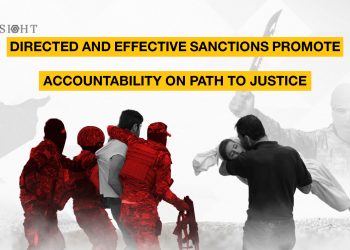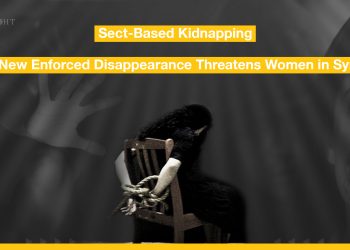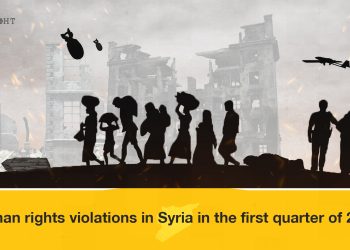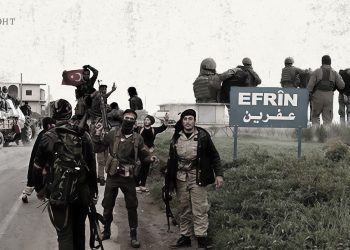Introduction and methodology:
On August 7th, Syrian government forces and its affiliated groups attacked the Syrian Democratic Forces in the countryside of Deir ez zor, causing a conflict that intensified nearly a week, in which the military parties did not respect the principle of distinguishing military objectives from civilian objects, resulting in civilian casualties.
The events and figures in this report are part of what ‘Insight’ documented and recorded in the areas of influence on the Euphrates banks of Deir ez zor’s countryside from August 7th to August 13th.
During the clash, Syrian government-backed or affiliated groups on the west bank of the Euphrates in the countryside of Deir ez zor shelled military points and residential areas on the other bank, SDF-controlled area. The conflict continued for more than a week, followed by relative calm, without the announce of a clear and long-term agreement that ensure the conflict would not recur.
International humanitarian law and the Universal Declaration of Human Rights recognize the right of civilians, including women and children, to protection during conflict, which requires the efforts of civil society organizations, local authorities, parties to conflict and their supporters to make a change in the severity and intensity of violations.
The parties to the conflict in east of Syria are called upon to adhere to the principle of distinguishing military objectives from civilian objects. The number of women and children victims are evidence of atrocities committed whenever populated areas are turned into a battlefield.
The families of the victims of this conflict, which suddenly erupted, faced difficult times losing individuals or being injured in mutual shelling, or their homes and property were damaged, forcing them to move to nearby areas until a cessation of military action.
The killing of 11 civilians at least in the village of ‘Dahlah’, on the east bank of Euphrates, was the most painful incident. The groups affiliated with government forces shelled the area and then re-targeted the mourners of the victims of the first shelling.
The incident, now described in the region as “carnage” or “massacre”, may be the main cause of the escalation over the following days and the delay in a rapid truce.
To prepare this report, ‘Insight’ conducted 10 online interviews with people in the conflict zone, 5 of whom were human rights activists and civilians, 2 were media workers and 3 were victims, all from villages and towns east of Euphrates.
The report was also based on videos and materials that were verified as valid and reliable, as well as statements and data made by parties to the conflict and political and administrative actors close to them.
The team neglected several videos that could not be verified or that had incited contents to retaliate and continue fighting, after seeking expert advice.
For the purpose of non-harm, we preferred not to name witnesses in an area where the conflict is still ongoing, we will refer to them as a civil or media activist or a victim.
The team faced difficulties in documenting the numbers of victims, as curfews and security constraint under continuing mutual shelling hampered the movement of activists and media personnel, and each party spoke of the victims within its area of influence and accused the opponent on the opposite bank of violations and crimes against civilians.
Civilian and military victims:
In seven days of this conflict, ‘Insight’ monitored the killing and injury of 37 civilians, mostly women and children. At least 17 civilians were killed (9 children and 6 women), and 20 civilians were injured (11 children and 5 women).
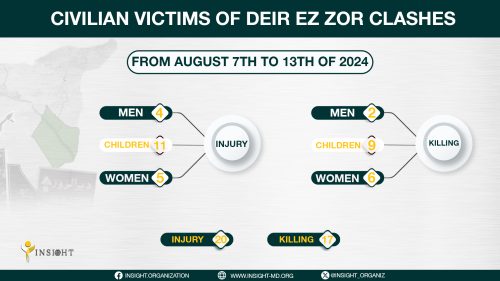
Previous figures indicate a high number of children then women among civilian victims, because there is no battlefield or large areas between the two sides, except the Euphrates River, where civilian homes are spread along its two banks.
Witnesses recalled that the security points and guards are distributed near the river banks as a line of contact between the two areas of influence, but that makes them close to or sometimes mediated by the houses on the bank.
The assailants’ use of artillery and mortar was a reason of missiles falling in area with inhabited houses, in the midst of operations when civilians consider their homes the most suitable place to hide from the shelling.
Three activists refer to the casualties in ‘Dahla’ as “deliberate” targeting of civilians.
A relative of the victims said that this “massacre” prevents families whose homes are located in neighborhoods near the east bank from returning back, even with calmness since August 13, because they fear that similar incidents could be repeated against their families.
The witness adds: “The majority of the victims are civilians, and the majority of the affected places are civilian property.”
The shelling was on the villages of ‘Sabha’, ‘Dahlah’, Thiban’ and nearby villages, as well as the villages of ‘Shu ‘itat’ (‘Abu Hamam’, ‘Kashkiya’ and ‘Granige’).
“There was no distinction of military sites from civilian homes in this conflict,” says a local media activist, “group commanders on the western side of Euphrates gave orders to fire missiles even if their path led to residential homes.”
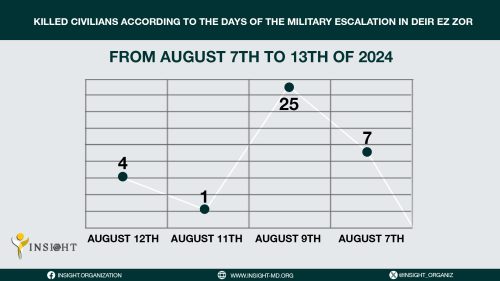
A civilian activist adds that efforts to document civilian casualties and damage to homes were not enough, “due to the ongoing fighting and restrictions on movement amid the security constraint”. He also said that confirmed evidence and information can be obtained only after the cessation of fighting and the return of displaced people.
‘Insight’monitored the killing and injury of 71 military personnel during the shelling and clashes in Deir ez-Zor from August 7th to 12th. At least 49 military personnel were killed and 22 were injured, followed by a cessation of the shelling and clashes in the region without a clear agreement.
The Syrian government is the responsible, for not seizing its “National Defense forces” or Iranian-backed groups during provocative attacks aimed at renewing tensions on the two banks of Euphrates, which have been stable and secure over the past weeks and months.
It is also responsible for the safety of its citizens on the east bank, even if they are in an area outside its influence, and must be the initiator of solutions that guarantee civil peace and stability rather than threaten it.
Fighting commanders of all groups involved in the conflict are also responsible for civilian casualties in any hostilities or reprisals.
International humanitarian law stipulates the principle of distinction in military operations of civilians and military personnel. However, this principle has been repeatedly violated since the start of the conflict in Syria. Civilians have suffered loss of life and objects as a result, with the absence of reparation programs, and the difficulty of conducting an urgent international investigation as a result of poor security conditions that hinder remedies.
Displacement and humanitarian reality:
Photos and videos that ‘Insight’ obtained from independent sources, showed that many homes in the villages of ‘Dahlah’, ‘Granige’, ‘Abu Hamam’ and Sabha were damaged by shells and bullets.
Health services and care have been damaged by power outages, in addition to a previous halt in support of international organizations for some hospitals and health centers.
In a statement on August 8th, the United Nations Office for the Coordination of Humanitarian Affairs in Syria said that fighting in Deir ez zor had killed civilians and damaged many civilian facilities, including water plants and a United Nations-supported rural livelihood center.
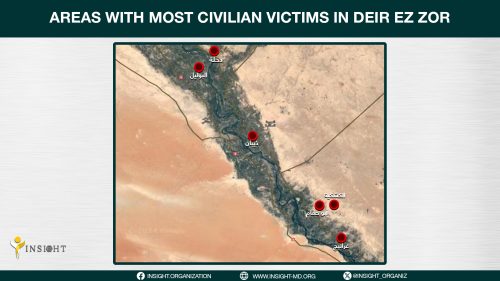
The fighting resulted in power outages at hospitals and water stations, all river crossings between the Euphrates banks of Deir ez zor were closed, and the people continued to suffer from scarce fuel, lack of health care and food insecurity, according to a statement that called on all parties to the conflict to respect international humanitarian law, including the protection of civilians and civilian infrastructure during military operations.
Activists, that ‘Insight’ contacted with, said that repeated shelling and curfews in villages, that became a military contact line, and security constraint had hampered the movement of local organizations, which in turn were unable to do anything.
Witnesses estimate the number of displaced people, due to the August 2024 conflict in Deir ez zor, a few thousand residents who have not moved away from their homes in the hope that the fighting will remain in specific areas.
The displacement on east bank of the Euphrates was higher than the other bank, although it was relative and in neighborhoods on the bank of the river. Some of its people have not returned back until mid-August, after three relatively calm days.
A human rights activist explained: “Displaced people did not cross the river, but retreated backwards, and residents of east Euphrates were exiting the near-bank area, known locally as ‘zor’, and crossing the general street of towns and villages towards the nearby suburbs and canyons (wilderness).”
The majority of the displacement took place in the villages of ‘Shu ‘itat’ (Abu Hamam, Kashkia, Granige), Biserah, Thiban and surrounding villages. Whereas the majority of the displaced families returned from central rural villages such as ‘Abu Hamam’, ‘Granige’ and ‘Sabha’, others preferred to wait a formal announcement of an agreement.
They explained that by saying they fear a sudden escalation, amid the spread of data and audio clips through social media, in which each party say they will respond and retaliate.
Some fathers and heads of the families prefer to check their homes during day times without taking their women and children.
Shelters perceived as safe and available by those fleeing the fighting were schools, centers of public institutions, homes of relatives and acquaintances, as local authorities and relief actors were unable to reach those areas within a week of fighting.
“There are no camps and none have been set during this conflict,” a witness said.
A civilian activist added: “Even before this conflict, organizations avoided working in some countryside where incidents of targeting and threats persisted.”
A second statement by the United Nations Office for the Coordination of Humanitarian Affairs (OCHA) in Syria, issued on 15 August, said that the conflict had hampered civilians’ access to essential services and humanitarian assistance, noting the continued closure of river crossings and high prices in the mainly difficult region.
The statement welcomed the restoration of humanitarian access in Hasakah governorate, which the Internal Security Forces (Asayish) of Autonomous Administration restricted entry and exit from Syrian government-held areas in the cities of Hasakah and Qamishli, northeastern Syria.
Unconfirmed media leaks said that meetings at Qamishli airport of commanders in Russian forces operating in Syria and SDF, concluded to end the security constraint on “security squares” in Hasakah governorate, without clear information on the alleged agreement.
Multiple forces:
Family and rural relations were the only help of displaced families amid the shelling that had lost the stability in the region.
Residents of Deir ez zor and its countryside have suffered war in Syria since 2011, and various forces have taken control of the area: government forces, armed opposition groups, Jabhat al Nusra and then the Islamic State (ISIS).
The Russian-backed Syrian government forces regained the center of the governorate and countryside of west bank of Euphrates, and the (SDF), supported by the Global Coalition to Fight ISIS, ended the group’s influence in its last stronghold in countryside of Deir ez zor in 2019.
The ” Shu’itat massacre” is the largest massacre of Syria’s war, it occurred in August of 2014, when ISIS killed hundreds of children, women and men.
If we compare the reality in Deir ez zor post ISIS with other areas that were previously under the control of the Islamic State, areas of Hasakah, Manbij and Raqqah, assassinations and ISIS activity continue in the countryside of Deir ez zor, along with desert areas and contact with the Syrian government-held areas and Iraq borders.
On the west bank (Al-Shamiya), there are Iranian military and the the Fourth Division and the “National Defence forces” of the government forces. The official media in Damascus attributed some military operations against SDF during the previous years to what they described as “Public Resistance”.
On the east bank of the river (al Jazira), the military council of Deir ez zor, which is affiliated with the SDF, is in control. There was security tensions and clashes in its region in autumn 2023, following the accusations of its former commander, Ahmed al-Khabil, of involving in the drug trade and relationship with pro-Iranians, which ended to isolating and arresting al-Khabil by the SDF.
The majority of witnesses in this report refuse to accuse the local population, tribes, elders and intellectuals of participating in the mobilization of battles and inflaming the conflict. They believe that groups, such as the “Public Resistance”, “Tribes’ Army” and “National Defense”, that all belong to government forces or its ally Iran, are responsible for its attacks, in addition to Iranian armed groups that include foreign members.
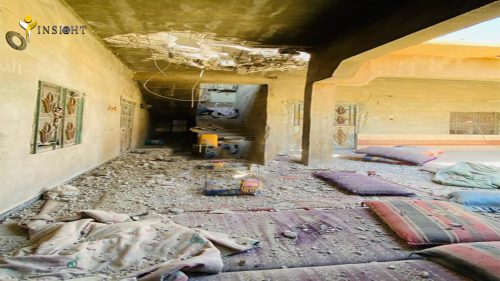
A rights activist accuses the attack leaders of carrying out foreign orders from Iran. Another activist would prefer to recall that a “reckless young man” joining these groups is not a valid measure of a full accusation of dependence on his family or village.
The director of a civil organization in the region said: “intellectuals played a major role in raising the awareness of the people about the risks of such conflict and the necessity to stop it.”
” the dignitaries and wise men among the civilians will not accept to involve the people in a local civil war “, she adds.
There are many foreign actors and participators involved in targeting and hostile operations in Deir ez zor. There is ISIS, Iranian forces, and the Global Coalition to Fight ISIS, as well as Syrian government and the Syrian Democratic Forces.
In first half of August, ISIS attacked Deir ez zor three times and Hasakah once.
In the same course of time, the SDF along with the Global Coalition to fight ISIS, carried out 3 security operations in Deir ez zor, Hasakah and Raqqa. The operations resulted in the killing of 2 persons and the arrest of 12 persons accused of belonging to ISIS.
In the first half of August, pro-Iranian factions attacked 3 of the Global Coalition’s military bases in north and east Syria, injuring at least 8 American soldiers. As a response, the U.S. forces shelled the Iranian factions’ site, resulting in unknown numbers of deaths and injuries.
Recommendations:
- Parties to conflict should not make residential areas as battles field where there is no distinction of military objectives, civilian objects or infrastructure.
- The Syrian government should deal with areas outside its control based on its responsibilities to protect citizens and restore civil peace in the country until a comprehensive political solution is made.
- Parties to the conflict and political and societal actors close to them must stop spreading hatred and revenge to involve people in a specific party or hostile to the other.
- The foreign parties involved in the conflict in Syria must not use undisciplined groups in hostilities, as this make them responsible under international humanitarian law and international human rights forums.
- Military parties must ensure that the ongoing understandings in Hasakah governorate are maintained and extended to Deir ez zor and its countryside.
- International civil and humanitarian organizations should assist displaced families to return safely to their homes and compensate those affected.
- Supporting the efforts to document and preserve evidence against the perpetrators who kill and injure civilians, for subsequent submission to national or international courts that bring justice to victims and their relatives.


